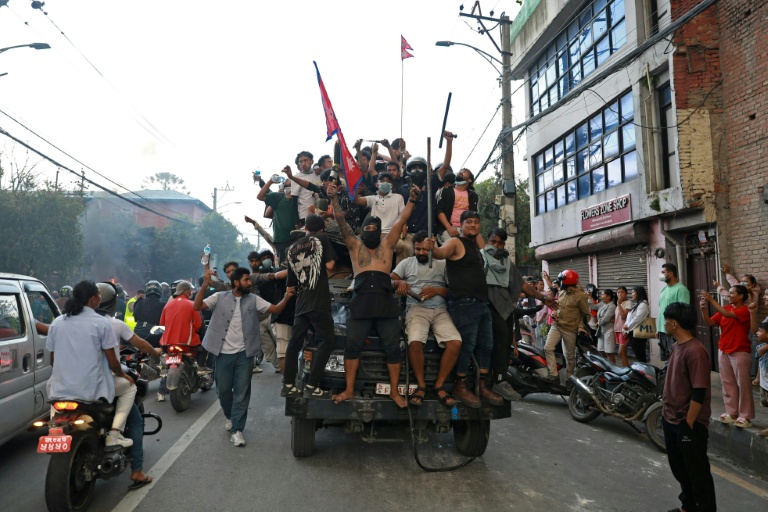Science
Nepal’s Protests Spark Misleading Religious Narratives in India

Protests in Nepal have escalated dramatically, leading to the resignation of Prime Minister KP Sharma Oli and the burning of several government buildings. The unrest erupted over allegations of corruption and a government ban on social media, yet the narrative has taken a different turn in neighboring India, where it is being misrepresented as a religious uprising.
Many in India are framing the demonstrations as a demand for a “Hindu state,” while others argue they represent an attack on Hinduism itself. These claims are bolstered by allegations from Indian media and politicians that protesters attempted to vandalize the Pashupatinath Temple, a significant Hindu site in Nepal. An anchor from the right-wing Zee News reported that rioters tried to damage the temple, which led to the deployment of the army.
In response to these claims, Jivesh Mishra, a member of India’s ruling Bharatiya Janata Party (BJP) in Bihar, stated, “An attack on a temple is an attack on (the) Hindu faith.” Right-wing influencers have also amplified these narratives to their substantial followings. Nevertheless, fact-checking by AFP revealed that the footage cited as evidence of vandalism was actually from a religious ceremony called Naxal Bhagwati Jatra, filmed weeks before the protests began.
Protests Driven by Youth Anger
The protests, which began in the capital city of Kathmandu on Monday, October 2, 2023, were ignited by a group of young activists identifying as the “Gen Z” movement. The demonstrations quickly transformed into widespread anger, resulting in a nationwide backlash against the government. Following a violent crackdown, public outcry culminated in the resignation of Prime Minister Oli, just days after protesters set fire to his residence.
Despite the clear motivations behind the protests, misinformation has proliferated online. Numerous social media posts lack evidence to support claims that the demonstrations were “instigated and funded” by “anti-Hindu forces and Islamists” aiming to attack religious sites. Since Nepal became a secular republic in 2008, there has been a recurring push from certain factions for a return to a Hindu state, but the current protests focus primarily on governance and transparency issues.
Misleading Narratives and Social Media Impact
Old footage of past rallies advocating for a Hindu monarchy has resurfaced, inaccurately presented as part of the current protests. One misleading image suggested that demonstrators wanted popular Hindu monk Yogi Adityanath as Nepal’s new prime minister. Comparisons between the unrest in Nepal and earlier protests in Bangladesh, where a student-led movement ousted a long-standing leader, have also gained traction.
In response to this wave of misinformation, Prashant Das, a senior research fellow at South Asian University, noted, “The urge to break news fast in India is higher, and that led to misinformation from their side.” He added that the current environment is rife with speculation and rumors, reflecting natural public reactions to unrest.
As the situation in Nepal continues to develop, it remains critical for accurate information to prevail amid the swirling narratives. The potential for political tensions in the region could further escalate if misinformation is allowed to shape perceptions of the protests.
-

 Science3 months ago
Science3 months agoToyoake City Proposes Daily Two-Hour Smartphone Use Limit
-

 Top Stories3 months ago
Top Stories3 months agoPedestrian Fatally Injured in Esquimalt Collision on August 14
-

 Health3 months ago
Health3 months agoB.C. Review Reveals Urgent Need for Rare-Disease Drug Reforms
-

 Technology3 months ago
Technology3 months agoDark Adventure Game “Bye Sweet Carole” Set for October Release
-

 World3 months ago
World3 months agoJimmy Lai’s Defense Challenges Charges Under National Security Law
-

 Lifestyle3 months ago
Lifestyle3 months agoVictoria’s Pop-Up Shop Shines Light on B.C.’s Wolf Cull
-

 Technology3 months ago
Technology3 months agoKonami Revives Iconic Metal Gear Solid Delta Ahead of Release
-

 Technology3 months ago
Technology3 months agoApple Expands Self-Service Repair Program to Canada
-

 Technology3 months ago
Technology3 months agoSnapmaker U1 Color 3D Printer Redefines Speed and Sustainability
-

 Technology3 months ago
Technology3 months agoAION Folding Knife: Redefining EDC Design with Premium Materials
-

 Business3 months ago
Business3 months agoGordon Murray Automotive Unveils S1 LM and Le Mans GTR at Monterey
-

 Technology3 months ago
Technology3 months agoSolve Today’s Wordle Challenge: Hints and Answer for August 19









